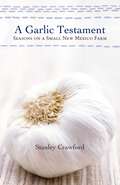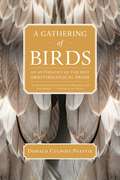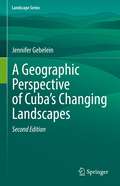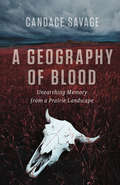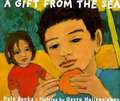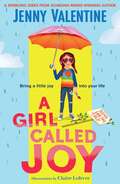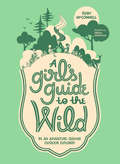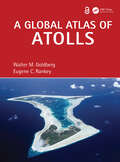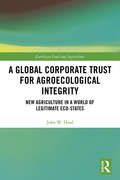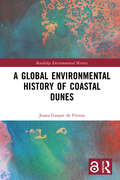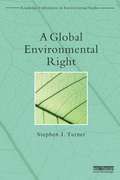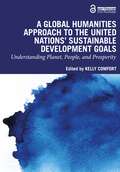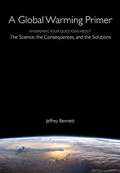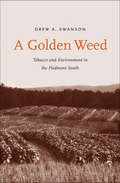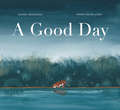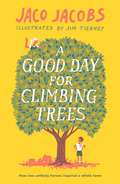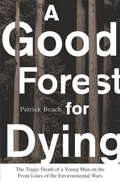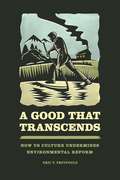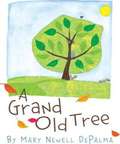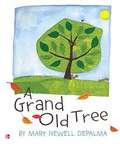- Table View
- List View
A Gardener's Handbook of Plant Names: Their Meanings and Origins
by A. W. SmithFirst compact dictionary to combine definitions of botanical names in general usage with information on their derivation and guides to pronunciation. A monumental index provides a cross-reference from some 1,800 common plant names to corresponding botanical ones. Combines thoroughness, botanical rigor, and interesting facts and lore — all leavened with touches of humor.
A Garlic Testament: Seasons on a Small New Mexico Farm
by Stanley CrawfordFrom his New Mexico mountain home, award-winning author Stanley Crawford writes about growing garlic and selling it. To dream a garden and then to plant it is an act of independence and even defiance to the greater world.--Stan Crawford
A Gathering of Birds
by Donald Culross PeattieA Gathering of Birds is an anthology containing selected prose about birds by nineteen famous authors, such as Hudson, Audubon, and Thoreau, and includes brief biographical information about each. The New York Times called the collection "a delightful 'gathering' that Mr. Peattie has presented, and his own contributions to the book make it something new and valuable in this field."
A Gathering of Birds
by Donald Culross PeattieA Gathering of Birds is an anthology containing selected prose about birds by nineteen famous authors, such as Hudson, Audubon, and Thoreau, and includes brief biographical information about each. The New York Times called the collection "a delightful 'gathering' that Mr. Peattie has presented, and his own contributions to the book make it something new and valuable in this field."
A Geographic Perspective of Cuba’s Changing Landscapes (Landscape Series #33)
by Jennifer GebeleinThis book is based on research that gives the reader a nonfiction view of how Cuba’s landscape has changed since the time when Columbus first set foot on the island and encountered the Indigenous peoples who lived there in 1492 to present day.An analysis of landscape change over time is presented and that transformation from a heavily forested island to less than (currently) 18% forest cover is described. The government has established a system of protected areas and strong governmental controls over environmental policies and the manner with which the island can be built upon by foreign investors, urban expansion projects, or natural resource exploitation.Current GIS and remote sensing research of Cuba’s atmosphere, physical landscape and aquatic features is provided to underscore the complex environmental structures that epitomize Cuba. The author discusses past, present and future impact factors including history, technological assessments, laws and policies, relationships with other countries and education.
A Geography of Blood
by Candace Savage*Finalist, Hilary Weston Writers' Trust Prize for Non-FictionWhen Candace Savage and her partner buy a house in the romantic little town of Eastend, she has no idea what awaits her. At first she enjoys exploring the area around their new home, including the boyhood haunts of the celebrated American writer Wallace Stegner, the back roads of the Cypress Hills, the dinosaur skeletons at the T.Rex Discovery Centre, the fossils to be found in the dust-dry hills. She also revels in her encounters with the wild inhabitants of this mysterious land-three coyotes in a ditch at night, their eyes glinting in the dark; a deer at the window; a cougar pussy-footing it through a gully a few minutes' walk from town.But as Savage explores further, she uncovers a darker reality-a story of cruelty and survival set in the still-recent past--and finds that she must reassess the story she grew up with as the daughter, granddaughter, and great-granddaughter of prairie homesteaders.Beautifully written, impeccably researched, and imbued with Savage's passion for this place, A Geography of Blood offers both a shocking new version of plains history and an unforgettable portrait of the windswept, shining country of the Cypress Hills.
A Geoinformatics Approach to Water Erosion: Soil Loss and Beyond
by Tal SvorayDegradation of agricultural catchments due to water erosion is a major environmental threat at the global scale, with long-lasting destructive consequences valued at tens of billions of dollars per annum. Eroded soils lead to reduced crop yields and deprived agroecosystem’s functioning through, for example, decreased water holding capacity, poor aeration, scarce microbial activity, and loose soil structure. This can result in reduced carbon sequestration, limited nutrient cycling, contamination of water bodies due to eutrophication, low protection from floods and poor attention restoration—consequences that go far beyond the commonly modelled soil loss and deposition budgets. This book demonstrates, using data from the Harod catchment in northern Israel, how cutting-edge geoinformatics, data science methodologies and soil health indicators can be used to measure, predict, and regulate these major environmental hazards. It shows how these approaches are used to quantify—in time and space—the effect of water erosion not only on the soil layer, soil minerals, and soil loss, but also on the wide-range of services that agricultural ecosystems might supply for the benefit and well-being of humans. The algorithms described in this book play a major role in this paradigm shift and they include, for example, extraction of photogrammetric DEMs from drone's data, advanced drainage structure calculations, fuzzy process-based modelling and spatial topographic threshold computations, multicriteria analyses and expert-based systems development using analytic hierarchal processes, innovative data-mining and machine learning tools, autocorrelation and interpolation of soil health, physically-based soil evolution models, spatial decision support systems and many more.
A Gift From The Sea
by Kate Banks Georg Hallensleben K Banks"Banks and Hallensleben make beautiful books together." -- American Bookseller A boy picks up a rock that he finds on the beach. He holds it in his hand, and admires it. He doesn't know that the rock has been on a great journey through time in making its way to him: that it was spewed forth from a fiery volcano, then altered by eons of wind and rain, frozen during the ice age, and finally carried out into the ocean, where it lay on the floor of the sea before being thrust onto the shore at his feet. But he does know that it is a gift from the sea. Kate Banks and Georg Hallensleben combine their talents to tell a story that is as wonderfully simple as it is profound.
A Girl Called Joy: Bring a little JOY into your life! (A Girl Called Joy #1)
by Jenny ValentineFor readers aged 9+ comes a SPARKLING new middle-grade series from Guardian award-winning author Jenny Valentine, perfect for fans of Jacqueline Wilson, Cath Howe and Lara Williamson! Meet ten-year-old Joy Applebloom, a girl with a knack for finding the silver lining in even the darkest of rainclouds. After years of travelling the world with her parents and older sister, Claude (Claude rhymes with bored, which is just about right), Joy and her family move to suburbia – back to school, back to her grumpy, rule-obsessed grandad and back to normality. Joy soon finds her usual irrepressible positivity and zest for life waning, but when the powers that be threaten to pull down a mighty oak tree, Joy decides to fight back, and realizes that not all magic requires wands and spells, and perhaps the most important sort of magic is the power, resilience and courage that was there all along . . .
A Girl and Five Brave Horses
by Sonora Carver Elizabeth LandSonora Carver, when she was 16 never dreamed that she would be in show business doing an act that was amazing and exciting. But when she ran into Dr. Carver, and saw the Diving Horses act, she fell in love. Sonora had a great life traveling the country, riding and doing shows, and loving the horses she worked with. Klataw, John the Baptist, Juda, Red Lips, Snow, and Lightning, all were her family and her friends. Then one day Red Lips did a very dramatic nose dive and Sonora hit the water with her eyes open and face first. Her life changed after that day and this is her story. This book was the inspiration for the movie "Wild Hearts Can't Be Broken".
A Girl's Guide to the Wild: Be an Adventure-Seeking Outdoor Explorer! (A Girl's Guide to the Wild)
by Ruby McConnellGirls belong outdoors! This handbook covers everything you need to get outside, including ideas for what to do, camping and hiking basics, body stuff in the wilderness, advanced skills like maps, weather, and first aid, as well as recipes, projects, activities, and profiles of inspiring outdoorswomen.Your definitive guide to getting outside--for girls ages 9-12! In addition to basic outdoor skills, this entertaining guidebook includes easy camping recipes, outdoor projects including science experiments and crafts, fun activity suggestions, and inspiring stories of diverse historical and contemporary outdoorswomen (such as Arunima Sinha, the first amputee woman to summit Mount Everest; Juliette Gordon Low, founder of the Girl Scouts; and Libby Riddles, first woman to win the Iditarod). The goal is to improve the quality of girls' outdoor time by increasing participation and independence, making them feel comfortable and safe, and giving them essential skills and knowledge. Charming and approachable, this book will encourage both reluctant campers and budding naturalists to go wild and embrace the outdoors.
A Global Atlas of Atolls
by Walter M. Goldberg Eugene C. RankeyScattered like dots rising from the deep across vast expanses of the world’s tropical and subtropical oceans, atolls with their turquoise lagoons and reefs teeming with colorful marine life have captured the public imagination. They have also been the homeland of millions of people for millennia as various groups of migrants spread across the far reaches if the Pacific, Indian and Western Atlantic regions. Developed from recently available satellite data, A Global Atlas of Atolls presents high-quality details of 476 atolls across the globe, characterizing aspects of the atoll rim, the lagoon, and their coral reef communities in unprecedented detail. In synthesizing and enhancing understanding of these unique seascapes, this volume provides a distinct compendium of descriptions and images, as well as documentation of the environmental conditions of winds, waves, and tides and a summary of the background literature for each atoll area. There is no comparable work.After an introduction that includes a glossary of terms, each atoll is documented in the form of an atlas written for scientists, but accessible to any diver or reader interested in these spectacular reef-island habitats. This book also describes some current challenges and perspectives on their future. It will be useful as a reference work for marine scientists, while providing a minimum of technical jargon for those who are not scientists, but who enjoy reading about exotic places with unusual attributes.Chapter 3 of this book is freely available as a downloadable Open Access PDF at http://www.taylorfrancis.com under a Creative Commons [Attribution-Non Commercial-No Derivatives (CC-BY-NC-ND)] 4.0 license.
A Global Corporate Trust for Agroecological Integrity: New Agriculture in a World of Legitimate Eco-states (Earthscan Food and Agriculture)
by John W. HeadThis book examines global environmental governance and how legal, institutional, and conceptual reform can facilitate a transformation to a new ‘natural-systems’ form of agriculture. Profound global climate disruption makes it essential that we replace our current agricultural system – described in this book as a fossil-carbon-dependent ‘modern extractive agriculture’ – with a natural-systems agriculture featuring perennial grains growing in polycultures, thereby mimicking the natural grassland and forest ecosystems that modern extractive agriculture has largely destroyed. After examining relevant international legal and conceptual foundations (sovereignty, federalism, global governance) and existing international organizations focusing on agriculture, the book explores legal and institutional opportunities to facilitate dramatic agricultural reform and ecological restoration. Among other things, it explains how innovative federalism structures around the world provide patterns for reorienting global environmental governance, including what the book calls eco-states that would, through exercise of pluralistic sovereignty, be responsible for agroecological management. Drawing from his experience working in international institutions, the author provides detailed global-governance proposals for facilitating the type of agricultural reform that can help avoid ecological collapse, especially through soil degradation and climate change. This book will be of great interest to students and scholars of international law, agroecology, climate change, ecological restoration, sustainable development, and global governance, as well as policy-makers and practitioners working in these fields.
A Global Environmental History of Coastal Dunes (Routledge Environmental History)
by Joana Gaspar de FreitasThis book provides a holistic perspective on coastal dunes, highlighting new insights into present-day challenges to show that narratives, along with numbers, graphics, and computer models, have a role to play in climate change science, policymaking, and citizenship awareness.Adopting a cross-disciplinary approach, this book combines fiction, history, and science, to discuss past, present, and future ways of living in coastal areas. Dunes are hybrid environments, a combination of natural elements and human agency; they tell stories of values, traditional wisdom, institutions, empires, technology, vulnerabilities, coastal management, adaptation, andsustainability. Drawing on the past, Joana Gaspar de Freitas unpacks a diverse and fascinating history of dunes, linking knowledge, methods, and approaches from several case studies across the world, including France, Portugal, Brazil, Mozambique, New Zealand, USA, and the UK. The book connects the bio geophysics of global change with the main driver of transformation— human agency—to integrate and address nature-society issues, taking human and nonhuman agents into account. In following the choices, paths, and strategies that created today’s coastal landscapes, the book generates greater awareness and understanding of how to shape coastal futures.This is an engaging, original, and, fundamentally, important book that fills a gap in our knowledge of cities, infrastructure, economies, and cultures built on shorelines. A key read for scholars, researchers, and students in environmental history, environmental science, sustainability, coastal land management, and climate change.
A Global Environmental Right (Routledge Explorations in Environmental Studies)
by Stephen TurnerThe development of an international substantive environmental right on a global level has long been a contested issue. To a limited extent environmental rights have developed in a fragmented way through different legal regimes. This book examines the potential for the development of a global environmental right that would create legal duties for all types of decision-makers and provide the bedrock for a new system of international environmental governance. Taking a problem solving approach, the book seeks to demonstrate how straightforward and logical changes to the existing global legal architecture would address some of the fundamental root causes of environmental degradation. It puts forward a draft global environmental right that would integrate duties for both state and non-state actors within reformed systems of environmental governance and a rational framework for business and industry to adhere to in order that those systems could be made operational. It also examines the failures of the existing international climate change regime and explains how the draft global environmental right could remedy existing deficits. This innovative and interdisciplinary book will be of great interest to policy-makers, students and researchers in international environmental law, climate change, environmental politics and global environmental governance as well as those studying the WTO, international trade law, human rights law, constitutional law and corporate law.
A Global Humanities Approach to the United Nations' Sustainable Development Goals: Understanding Planet, People, and Prosperity
by Kelly ComfortThis edited textbook explores the 17 UN SDGs through 12 works from the humanities, including films, novels, and photographic collections. It provides students with the knowledge and understanding of how the humanities engage in broader social, political, economic, and environmental dialogue, offering a global perspective that crosses national and continental borders. The book takes students through the UN SDGs from a theoretical perspective through to practical applications, first through specific global humanities examples and then through students’ own final projects and reflections. Centered around three major themes of planet, people, and prosperity, the textbook encourages students to explore and apply the Goals using a place-based, culturally rooted approach while simultaneously acknowledging and understanding their global importance. The text’s examples range from documentary and feature film to photography and literature, including Wang Jiuliang’s Plastic China, Kip Andersen and Keegan Kuhn’s Cowspiracy: The Sustainability Secret, Barbara Dombrowski’s Tropic Ice: Dialog Between Places Affected by Climate Change, and Aravind Adiga’s The White Tiger, among others. Providing diverse geographic and cultural perspectives, the works take readers to Argentina, Australia, China, Costa Rica, Ecuador, France, Greenland, Haiti, India, Japan, Peru, Rwanda, Senegal, and the United States. This broad textbook can be used by students and instructors at undergraduate and postgraduate levels from any subject background, particularly, but not exclusively, those in the humanities. With added discussion questions, research assignments, writing prompts, and creative project ideas, students will gain a nuanced understanding of the interconnectivity between social, cultural, ethical, political, economic, and environmental factors.
A Global Warming Primer: Answering Your Questions About The Science, The Consequences, And The Solutions
by Jeffrey BennettIs human-induced global warming a real threat to our future? Most people will express an opinion on this question, but relatively few can back their opinions with solid evidence. Many times we've even heard pundits say "I am not a scientist" to avoid the issue altogether. But the truth is, the basic science is not that difficult. Using a question and answer format, this book will help readers achieve three major goals: To see that anyone can understand the basic science of global warming; To understand the arguments about this issue made by skeptics, so that readers will be able to decide for themselves what to believe; To understand why, despite the "gloom and doom" that often surrounds this topic, the solutions are ones that will not only protect the world for our children and grandchildren, but that will actually lead us to a stronger economy with energy that is cheaper, cleaner, and more abundant than the energy we use today.
A Globally Integrated Climate Policy for Canada
by Steven Bernstein Andrew Green David Duff Jutta BruneeCanada has been an engaged participant in global climate change negotiations since the late 1980s. Until recently, Canadian policy seemed to be driven in large part by a desire to join in multilateral efforts to address climate change. By contrast, current policy is seeking a "made in Canada" approach to the issue. Recent government-sponsored analytic efforts as well as the government's own stated policies have been focused almost entirely on domestic regulation and incentives, domestic opportunities for technological responses, domestic costs, domestic carbon markets, and the setting of a domestic carbon "price" at a level that sends the appropriate marketplace signal to produce needed reductions. A Globally Integrated Climate Policy for Canada builds on the premise that Canada is in need of an approach that effectively integrates domestic priorities and global policy imperatives. Leading Canadian and international experts explore policy ideas and options from a range of disciplinary perspectives, including science, law, political science, economics, and sociology. Chapters explore the costs, opportunities, or imperatives to participate in international diplomatic initiatives and regimes, the opportunities and impacts of regional or global carbon markets, the proper mix of domestic policy tools, the parameters of Canadian energy policy, and the dynamics that propel or hinder the Canadian policy process.
A Golden Weed
by Dr Drew A. SwansonDrew A. Swanson has written an "environmental" history about a crop of great historical and economic significance: American tobacco. A preferred agricultural product for much of the South, the tobacco plant would ultimately degrade the land that nurtured it, but as the author provocatively argues, the choice of crop initially made perfect agrarian as well as financial sense for southern planters. Swanson, who brings to his narrative the experience of having grown up on a working Virginia tobacco farm, explores how one attempt at agricultural permanence went seriously awry. He weaves together social, agricultural, and cultural history of the Piedmont region and illustrates how ideas about race and landscape management became entangled under slavery and afterward. Challenging long-held perceptions, this innovative study examines not only the material relationships that connected crop, land, and people but also the justifications that encouraged tobacco farming in the region.
A Good Day
by Daniel NesquensThe cat and the tiger are best friends. Every day, the cat enters the zoo and visits the tiger&’s cage. They talk about everything, but when the cat confesses that he&’d like to be big and strong like the tiger, he&’s shocked to learn that the tiger envies him for being free to go wherever he wants. The tiger has a plan to escape from the zoo and find his real home—all he needs is some help from his best friend. Animal lovers of all ages will fall in love with this fanciful story about friendship and freedom.
A Good Day for Climbing Trees
by Jaco Jacobs*Nominated for the 2019 CILIP Carnegie Medal* How two unlikely heroes inspire a whole town by fighting to save a tree Sometimes, in the blink of an eye, you do something that changes your life forever. Like climbing a tree with a girl you don't know. Marnus is tired of feeling invisible, living in the shadow of his two brothers. His older brother is good at breaking swimming records and girls&’ hearts. His younger brother is already a crafty entrepreneur who has tricked him into doing the dishes all summer. But when a girl called Leila turns up on their doorstep one morning with a petition, it&’s the start of an unexpected adventure. And finally, Marnus gets the chance to be noticed...
A Good Forest for Dying: The Tragic Death of a Young Man on the Front Lines of the Environmental Wars
by Patrick BeachEarly on a September morning in 1998, David “Gypsy” Chain and eight fellow Earth First! activists went into the redwood forests of Scotia, California. Their loosely organized plan to protest the destruction caused by the logging industry almost immediately turned farcically tragic. A. E. Ammons, a logger for Pacific Lumber, confronted the group, threatening them in an obscenity-ridden diatribe: if they didn't leave "I'll make sure I got a tree comin' this way!" The group retreated, moving deeper into the wilderness. A short time later, just as they were attempting to confront the logger yet again, Gypsy was dead, crushed to death by a tree Ammons felled. A GOOD FOREST FOR DYING traces the long history of bitter clashes between environmental concerns and economic interests in the American West and shows why these tensions came to a head in northern California in the 1990s. It tells the story of how Pacific Lumber, once an environmentally friendly, family-owned business, became part of a conglomerate whose business practices made it a ripe target for environmental activists. But A GOOD FOREST FOR DYING is also the story of Gypsy Chain, a troubled young man raised in a loving family. A social misfit in his small Texas hometown, he died in a faraway forest before he had a chance to come to terms with himself and his family. His mother never lost faith in her sometimes wayward, idealistic son. After his death, and helped by a team of shrewd, leftist lawyers, she mounted a fight for justice in the name of her son and the cause of saving the redwoods. A balanced, highly readable examination of complex, emotionally charged issues, A GOOD FOREST FOR DYING will appeal to a wide audience. Its insights into the inner workings of the radical environmental movement and its dissection of corporate greed and misdeeds are reminiscent of such provocative exposés as A Civil Action and Erin Brockovich. The story of Gypsy’s strange odyssey and the disturbing circumstances of his death–seen primarily through the eyes of his mother–is as powerful and as moving as Jon Krakauer’s classic Into the Wild.
A Good That Transcends: How US Culture Undermines Environmental Reform
by Eric T. FreyfogleSince the birth of the modern environmental movement in the 1970s, the United States has witnessed dramatic shifts in social equality, ecological viewpoints, and environmental policy. With these changes has also come an increased popular resistance to environmental reform, but, as Eric T. Freyfogle reveals in this book, that resistance has far deeper roots. Calling upon key environmental voices from the past and present—including Aldo Leopold, Wendell Berry, David Orr, and even Pope Francis in his Encyclical—and exploring core concepts like wilderness and the tragedy of the commons, A Good That Transcends not only unearths the causes of our embedded culture of resistance, but also offers a path forward to true, lasting environmental initiatives. A lawyer by training, with expertise in property rights, Freyfogle uses his legal knowledge to demonstrate that bad land use practices are rooted in the way in which we see the natural world, value it, and understand our place within it. While social and economic factors are important components of our current predicament, it is our culture, he shows, that is driving the reform crisis—and in the face of accelerating environmental change, a change in culture is vital. Drawing upon a diverse array of disciplines from history and philosophy to the life sciences, economics, and literature, Freyfogle seeks better ways for humans to live in nature, helping us to rethink our relationship with the land and craft a new conservation ethic. By confronting our ongoing resistance to reform as well as pointing the way toward a common good, A Good That Transcends enables us to see how we might rise above institutional and cultural challenges, look at environmental problems, appreciate their severity, and both support and participate in reform.
A Grand Old Tree
by Mary NewellThis book depicts the nurturing nature of a tree which provides bountiful when it is young and still nurtures even after it is dead.

